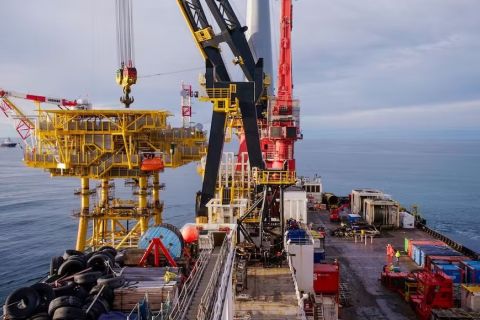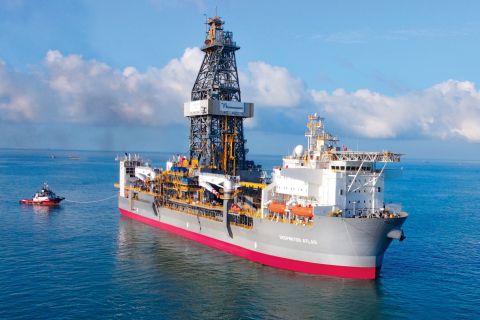U.S. natural gas futures rose about 2% on March 9 on forecasts for colder weather and higher heating demand over the next two weeks than previously expected and a slightly bigger-than-expected withdrawal of gas from storage last week.
Prices also rose as the amount of gas flowing to Freeport LNG's export plant in Texas increased in recent days, after declining earlier in the week.
The U.S. Energy Information Administration (EIA) said utilities pulled 84 Bcf of gas from storage during the week ended March 3.
That was a little more than the 80-Bcf withdrawal analysts forecast in a Reuters poll and compares with a decrease of 126 Bcf in the same week last year and a five-year (2018-2022) average decline of 101 Bcf.
That decrease cut stockpiles to 2.030 Tcf, or 21.5% above the five-year average.
Analysts said last week's storage withdrawal was lower-than-usual for this time of year because mild weather kept heating demand for the fuel low.
Front-month gas futures for April delivery rose $0.049 cents, or 1.9%, to $2.60 per MMBtu at 10:39 a.m. EST (1539 GMT). On March 9, the contract fell about 5% to its lowest close since Feb. 24.
The market has been extremely volatile in recent weeks as traders bet on the latest weather forecasts.
The front-month fell to a 28-month low below $2 per MMBtu in intraday trade on Feb. 22 on forecasts for warmer weather before jumping 9% to settle at a five-week high over $3 just over a week later on March 3 on forecasts for colder weather and then plunging 15% on March 6 on an outlook for warmer temperatures.
Freeport LNG's export plant, meanwhile, was on track to pull in 0.8 Bcf/d of gas for a second day in a row on March 9, up from just 0.2 Bcf/d on March 7, according to data provider Refinitiv. Freeport exited an eight-month outage in February. That outage was caused by a fire in June 2022.
When operating at full power, Freeport LNG, the second-biggest U.S. LNG export plant, can turn about 2.1 Bcf/d of gas into LNG for export.
Federal regulators approved the restart of two of Freeport LNG's three liquefaction trains (Trains 2 and 3) in February and the third train (Train 1) on March 8. Liquefaction trains turn gas into LNG.
Total gas flows to all seven of the big U.S. LNG export plants rose to an average of 13.2 Bcf/d so far in March from 12.8 Bcf/d in February. That would top the monthly record of 12.9 Bcf/d in March 2022, before the Freeport LNG facility shut.
The seven big U.S. LNG export plants, including Freeport LNG, can turn about 13.8 Bcf/d of gas into LNG.
Rig count falls
Refinitiv said average gas output in the U.S. Lower 48 states rose to 98.6 Bcf/d so far in March from 98.2 Bcf/d in February. That compares with a monthly record of 99.9 Bcf/d in November 2022.
Analysts said production declined earlier this year due in part to drops in gas prices of 40% in January and 35% in December that persuaded several energy firms to reduce the number of rigs they were using to drill for gas.
In addition, extreme cold in early February and late December cut gas output by freezing oil and gas wells in several producing basins.
Meteorologists projected weather in the Lower 48 states would remain mostly colder-than-normal through March 24 after some near- to warmer-than-normal days from March 9-11. That is a colder forecast than previously expected.
With colder weather coming, Refinitiv forecast U.S. gas demand, including exports, would rise from 115.8 Bcf/d this week to 119.6 Bcf/d next week. Those forecasts were higher than Refinitiv's outlook on March 8.
Recommended Reading
TotalEnergies Fénix Platform Installed Offshore Argentina
2024-02-13 - First gas from the TotalEnergies-operated project is expected in fourth-quarter 2024.
E&P Highlights: Feb. 16, 2024
2024-02-19 - From the mobile offshore production unit arriving at the Nong Yao Field offshore Thailand to approval for the Castorone vessel to resume operations, below is a compilation of the latest headlines in the E&P space.
CNOOC Sets Increased 2024-2026 Production Targets
2024-01-25 - CNOOC Ltd. plans on $17.5B capex in 2024, with 63% of that dedicated to project development.
Rystad: More Deepwater Wells to be Drilled in 2024
2024-02-29 - Upstream majors dive into deeper and frontier waters while exploration budgets for 2024 remain flat.
Deepwater Roundup 2024: Offshore Africa
2024-04-02 - Offshore Africa, new projects are progressing, with a number of high-reserve offshore developments being planned in countries not typically known for deepwater activity, such as Phase 2 of the Baleine project on the Ivory Coast.





